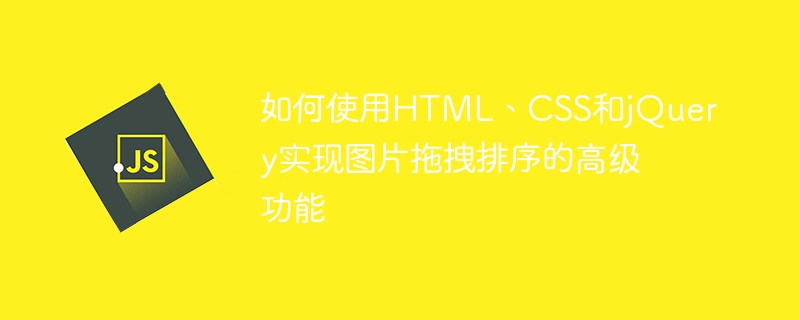

How to use HTML, CSS and jQuery to implement the advanced function of drag-and-drop sorting of images
In modern website design, drag-and-drop sorting of images is a very common function . It allows users to sort and rearrange pictures on the page in an intuitive way, thereby improving user experience. This article will introduce how to use HTML, CSS and jQuery to implement the advanced function of image drag and drop sorting, and provide specific code examples.
HTML structure:
First, we need to create an HTML structure for the image. Each image will be wrapped in a div element, and a specific class will be added to each div element, and a unique id will be set so that we can position them in subsequent operations.
<div class="draggable" id="image1"> <img src="/static/imghw/default1.png" data-src="image1.jpg" class="lazy" alt="Image 1"> </div> <div class="draggable" id="image2"> <img src="/static/imghw/default1.png" data-src="image2.jpg" class="lazy" alt="Image 2"> </div> <div class="draggable" id="image3"> <img src="/static/imghw/default1.png" data-src="image3.jpg" class="lazy" alt="Image 3"> </div>
CSS Styles:
Next, we need to add some basic styles to the images so that they display and layout correctly on the page. In order to achieve the drag effect, we also need to set the position of the image to absolute positioning, and ensure that the image can cover other elements by setting the z-index attribute.
.draggable {
position: absolute;
z-index: 1;
cursor: move;
}
.draggable img {
width: 200px;
height: 200px;
}jQuery drag-and-drop and sorting function:
Now, we are ready to implement the drag-and-drop and sorting function of images. By using jQuery's draggable and sortable plugins, we can achieve this functionality and be able to rearrange the order of images based on user actions.
First, we need to introduce the jQuery library and corresponding plug-ins. We can then use the following code to initialize the draggable plugin.
$(".draggable").draggable({
revert: "invalid",
helper: "clone",
cursor: "move",
});This code will enable the image to be dragged and returned to its original position when the drag is completed.
Next, we need to use the sortable plug-in to define the logic of image sorting. The following is a sample code:
$("#sortable").sortable({
placeholder: "sortable-placeholder",
revert: true,
opacity: 0.8,
update: function(event, ui) {
// 在排序完成后的回调中处理逻辑
// 您可以在这里更新数据库或执行其他操作
var sortedIDs = $(this).sortable("toArray");
console.log(sortedIDs);
}
});In this code, we add an id of "sortable" to a parent element. This element will become a container for sorting images. When the user sorts the pictures, we can obtain the order of the pictures after sorting through the update event processing function and print it to the console.
Finally, we need to set some CSS styles to define the animation effect and placeholder style when dragging.
.sortable-placeholder {
border: 1px dashed #ccc;
background: #f7f7f7;
height: 200px;
width: 200px;
}To sum up, through the combination of HTML, CSS and jQuery, we can easily realize the advanced function of drag-and-drop sorting of images. By dragging pictures, users can freely adjust the order of pictures to achieve personalized page layout. Using the above code example, you can further refine this functionality to suit your needs and apply it to your own website. I wish you the best to realize your creativity!
The above is the detailed content of How to use HTML, CSS and jQuery to implement the advanced function of drag-and-drop sorting of images. For more information, please follow other related articles on the PHP Chinese website!